
I LOVE ornamental oxalis in the garden!
Before you all think I’ve lost my mind, I’m not talking about the horribly invasive oxalis weed that threatens to take over lawns and gardens everywhere.
I’m talking about the many varieties of colorful and well-behaved ornamental oxalis hybrids.
The ornamental varieties often get overlooked in the nurseries, not because their foliage isn’t captivating (which it is), but because people are naturally suspicious of a plant named oxalis.
Poor oxalis – just saying the name causes many gardeners’ blood to run cold.
So worried gardeners pass on by the 4” pots at the nursery, never getting the chance to see how incredible these little beauties can be in their garden.
Over the years, I’ve planted several varieties in my garden and thought I’d share with you those that have proven to withstand the test of time, reliably returning each spring.
Oxalis siliquosa ‘Sunset Velvet’
Quite possibly, the most beautiful ornamental oxalis of all is ‘Sunset Velvet’ (also in the photo above.)
The delicate clover-like foliage always seems to be changing color. In spring, the leaves emerge a bright green color, complemented by red stems.

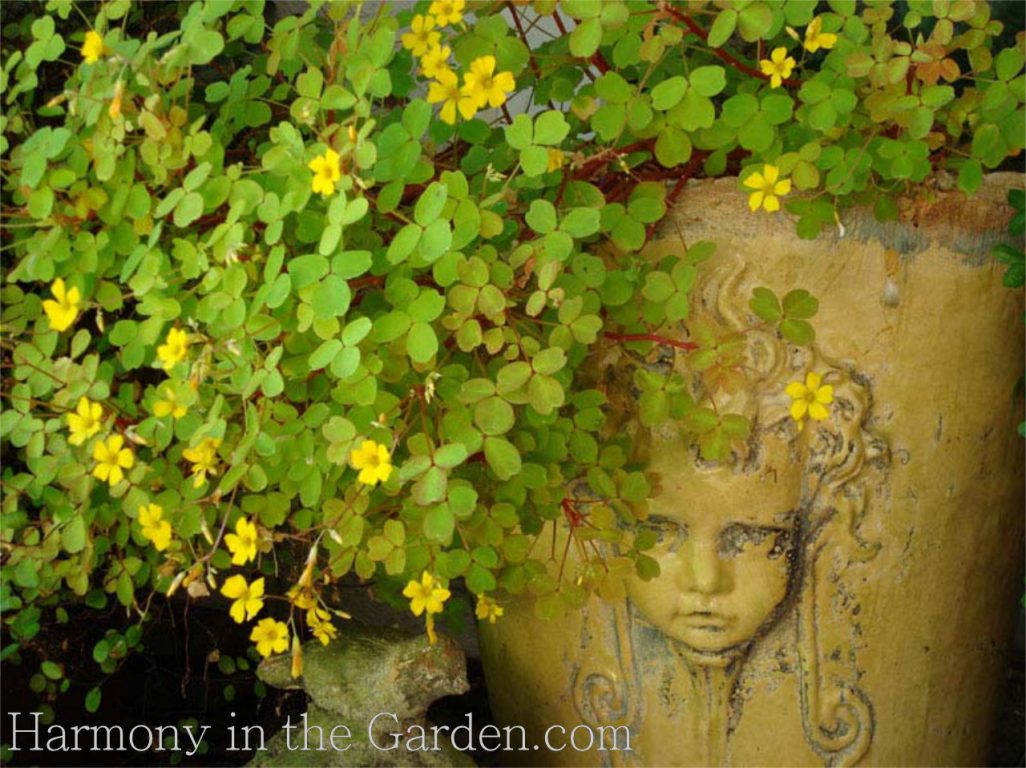
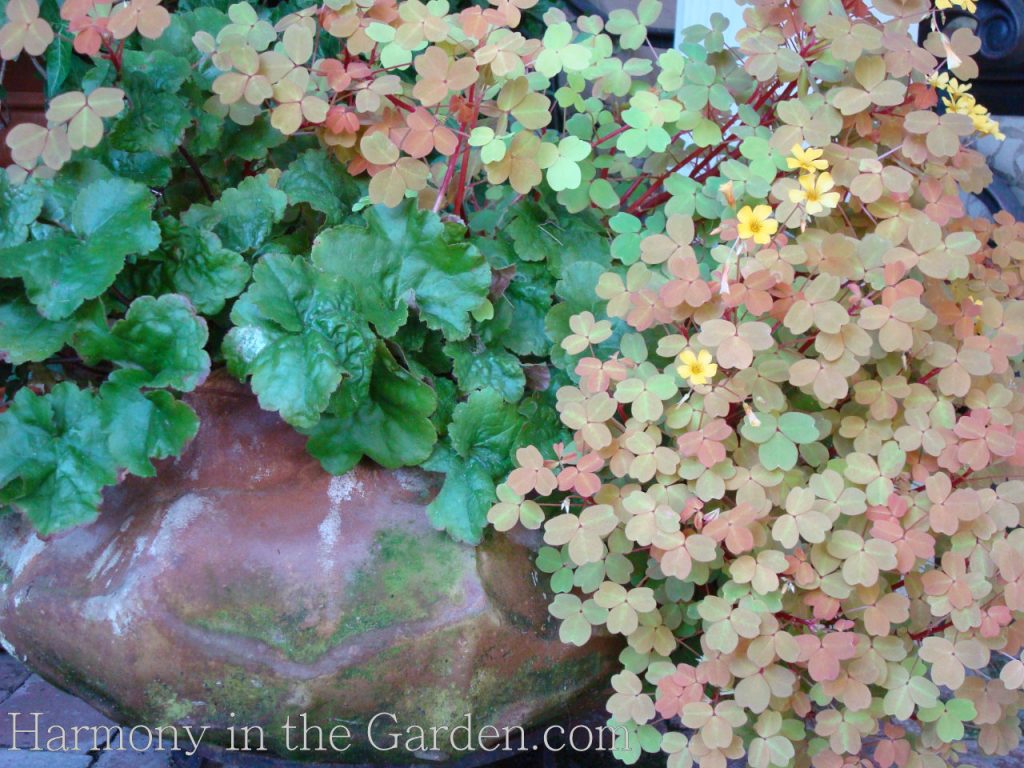
But, as the temperatures warm up, the lime green turns to shades of terra cotta and peach.
Colors that perfectly complement the zillions of happy little yellow flowers that start to make their appearance.
And talk about long-lasting – these flowers bloom for months at a time!
As fall and winter settle in, the shades intensify with ‘Sunset Velvet’ putting on its best show yet, with rich gold and amber tones.

One of the things I appreciate most about ‘Sunset Velvet’ is how it blends with just about any container you might have. Terra cotta, ceramic, tile, zinc – you name it, this variety is a natural companion.
‘Sunset Velvet’ has been evergreen in my zone 9 garden, lasting 4-5 years before needing to be replaced.
Planted in bright shade, it has survived the hottest days and the coldest nights (down to the high 20’s) without a complaint!
It grows to 10” or so, and when planted in a container will gently cascade over the sides.
Oxalis spiralis vulcanicola
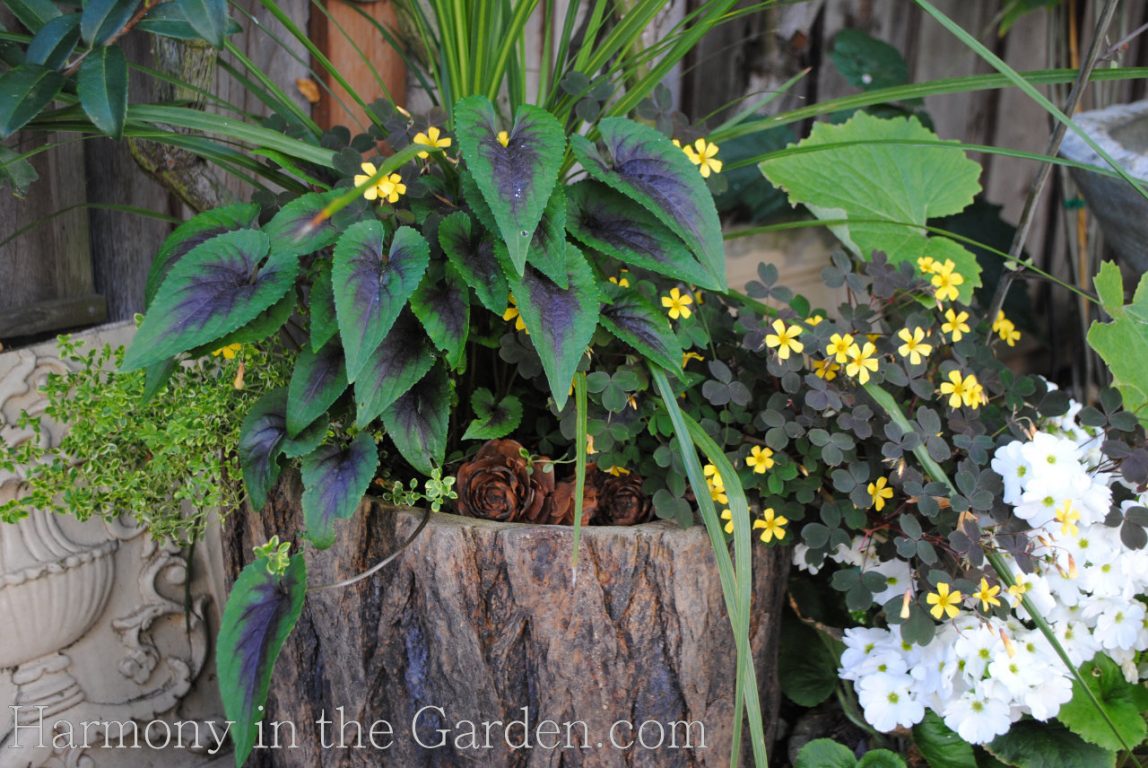
This is another variety that does well in zones 8 and up, growing to a tidy 15” x15”. As with most other oxalis, it blooms spring through fall with the cutest yellow flowers.
I’m a sucker for any plant with maroon foliage.
The dark burgundy color (really, it’s almost black!) is a fantastic way to add the illusion of depth to a garden, as the nature of the color will visually recede.
While burgundy recedes, lighter colors (especially bright green or silver) will appear to move forward, therefore creating the illusion of depth.

I love this combination for a few reasons.
Not only does the dark maroon variegation of the viola ‘Heartthrob’ harmonize with oxalis’s burgundy foliage, but the bright green color helps to emphasize the ‘depth’ that I was referring to, above.
I’m particularly fond of planting this variety in containers made of similarly dark materials, like the faux bois container above, or my burnished copper window box.
(click here to read how I design this window box for four seasons!)
Oxalis triangularis ‘Charmed Wine’ (False Shamrock)
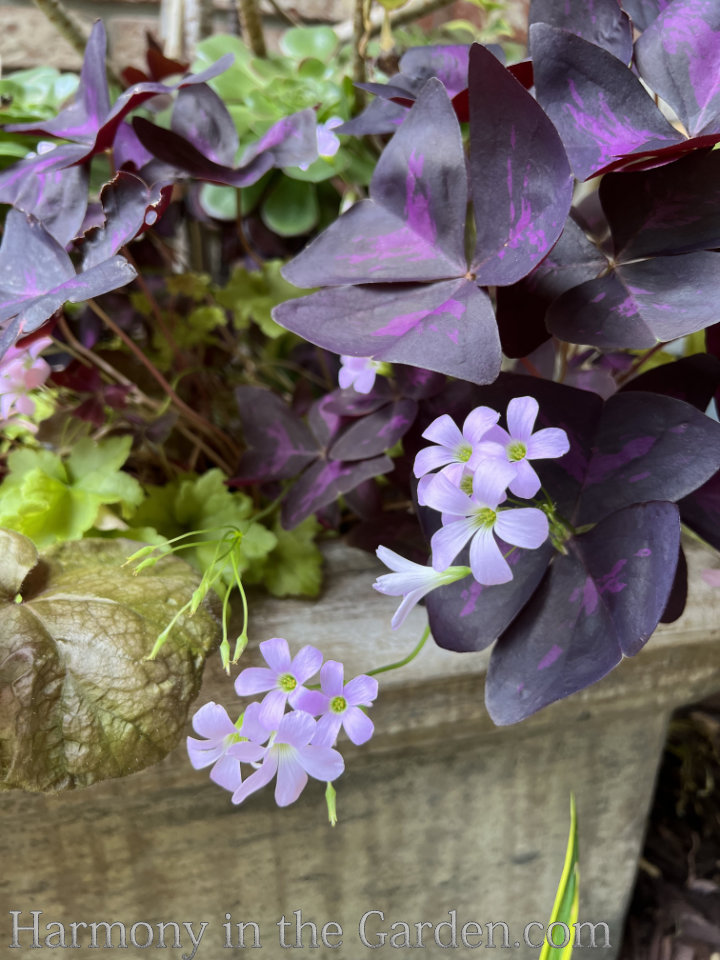
The dark plum foliage of ‘Charmed Wine’ is much larger than the above varieties, resembling a giant, traditional shamrock.
Growing from tiny bulblets, this variety has reliably returned for many years when planted in various containers.
I have one plant that has been with me for eight years now, due to the fact that it’s one of the most cold-hardy oxalis out there – hardy down to zones 7b.
And those flowers! The tiny soft lavender blooms start appearing in early summer, lasting for several weeks. To me, they’re the icing on the cake.
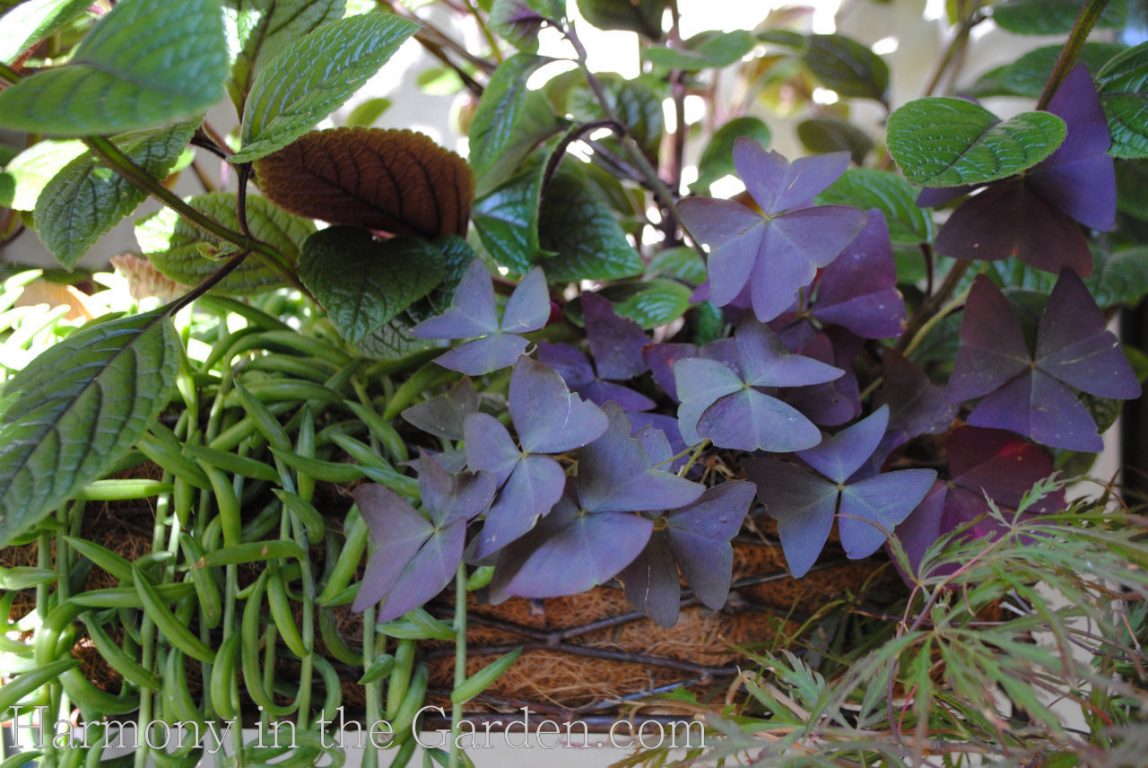
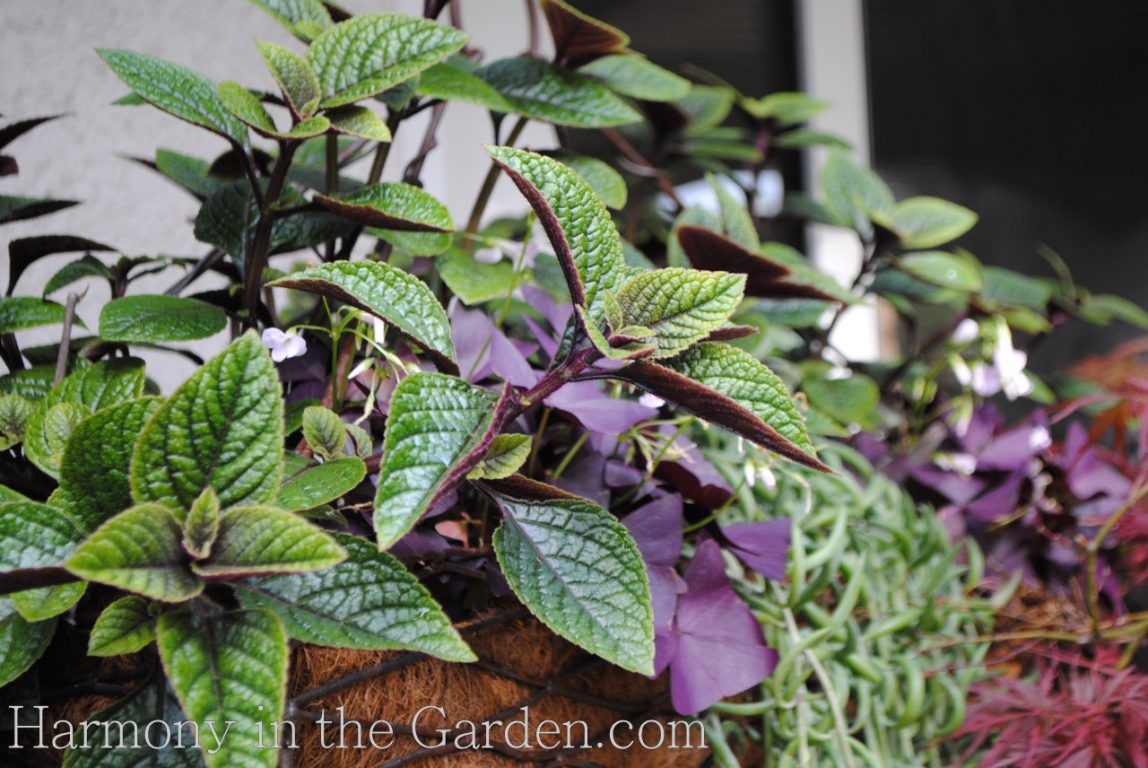
I’ve had many people tell me they’re not quite sure how to incorporate the vibrant (and somewhat garish) tones of the ‘Charmed Wine’ foliage within their containers.
I like to pair them with a plant that has similar (yet subtler) shades, like this plectranthus ciliates. The result is an unexpected color combination that helps tone down the intensity of the ‘Charmed Wine’ foliage.
The triangularis varieties tend to fold their leaves down at night, forming tight little clusters, re-opening again in the morning, resulting in their common name of ‘Butterfly Shamrocks.’
Oxalis triangularis
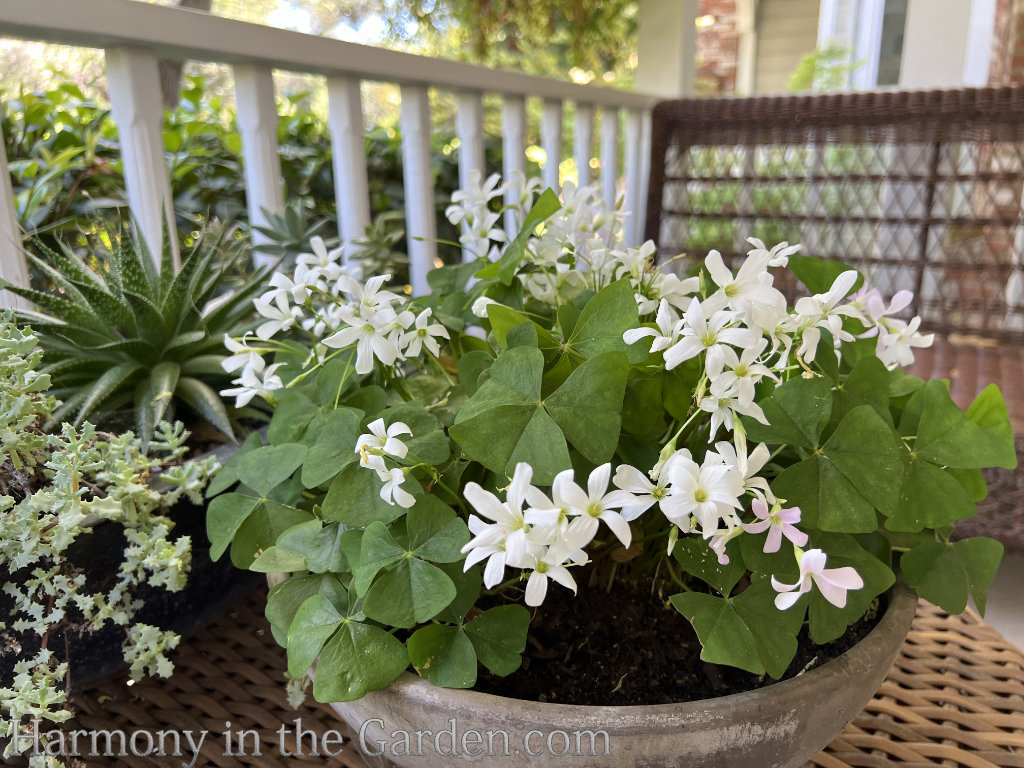
This is another False Shamrock, similar to the above, but with refreshing crisp white flowers and bright green foliage.
This variety blooms for several months starting in early March and adds such a burst of happiness to the early spring garden.
I highly recommend adding this low-growing ground cover (12″ at the highest point) this to brighten up a shady garden.
Oxalis deppei ‘Iron Cross’
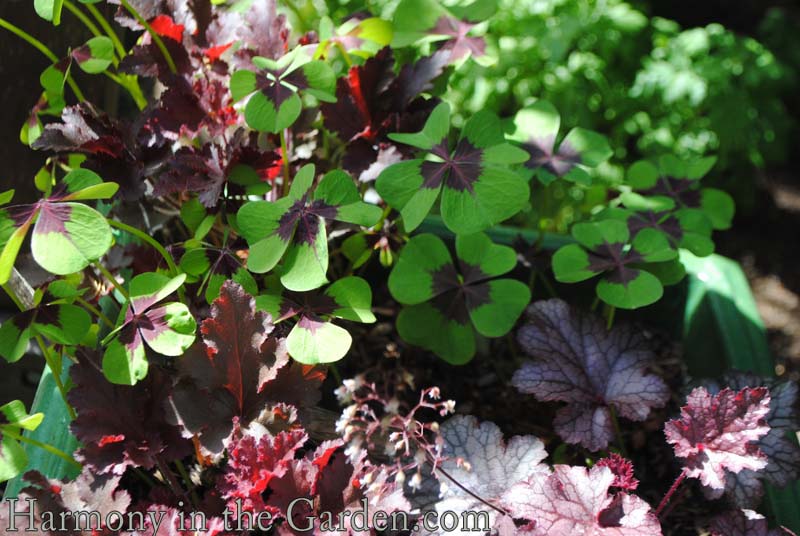
While most ornamental oxalis varieties are from South America and South Africa, ‘Iron Cross’ hails from Mexico.
However, similar to triangularis, above, this oxalis is also a tuber with little bulblets. This translates into being a better choice for colder climates – when dormant, they’re hardy down to 10-15 degrees.
Similar to oxalis vulcanicola, the burgundy and bright green variegation make this variety a spectacular choice for creating harmonious color echoes.
I’ve even read that this variety is edible in moderation, with a lemony flavor (not sure if all are edible, or just this one.)
Oxalis corniculate – the dreaded weed!

I can’t possibly write a post about oxalis without mentioning oxalis corniculate – the terrible, horrible weed we’ve all encountered in our lawns and gardens.
Removing them can be a nightmare, but especially if you don’t act fast.
I have the best luck when I dig them out the second I see them, hopefully while they’re still young and compact.
If you wait too long, they’ll quickly set seed, and away they go! It’s also imperative that you get every last bit of their roots, otherwise, they’ll grow right back again.
Hands Down – the BEST tool to remove oxalis weeds is the CobraHead Weeder & Cultivator.

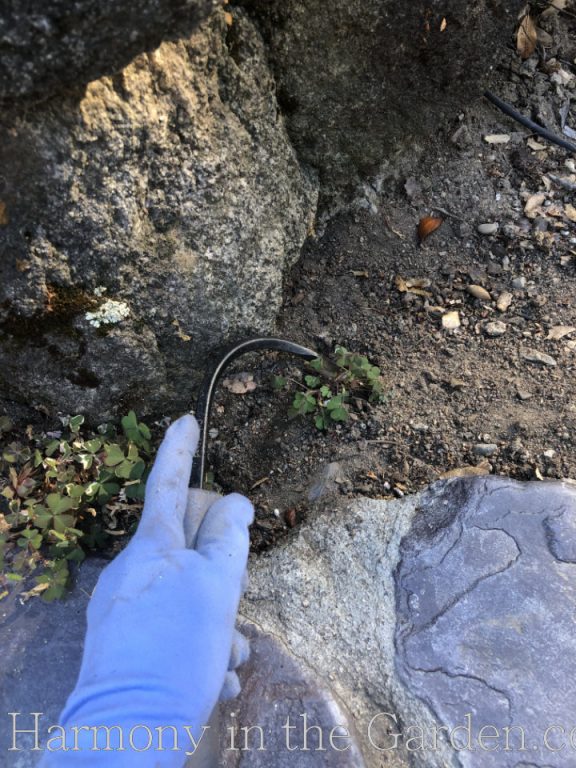


As you can see from these photos, the CobraHead has a wide, spoon-shaped end that has a pointed tip (they refer to it as a ‘steel fingernail, a perfect description!)
It’s this design, coupled with the steel blade, that makes it super fast and easy (and dare I say sorta fun?) to quickly uproot the weed, along with its entire root ball.
CobraHead is an amazing family-run business that makes all of their tools in Wisconsin, using environmentally friendly materials whenever possible (you can read more about why I love this company and this tool, here.)
Also, that’s my hand (above), wearing my favorite pair of blue Foxgloves, which are perfect for weeding as they’re snug and allow you to feel for stems and roots. You can read my review here.
In addition, I also mulch with a hefty layer of shredded bark (3” deep is ideal) to suppress all weeds.
While oxalis will still grow up and through the mulch, by the time it reaches the top, it’s usually so leggy it’s much easier to remove.
More varieties to try
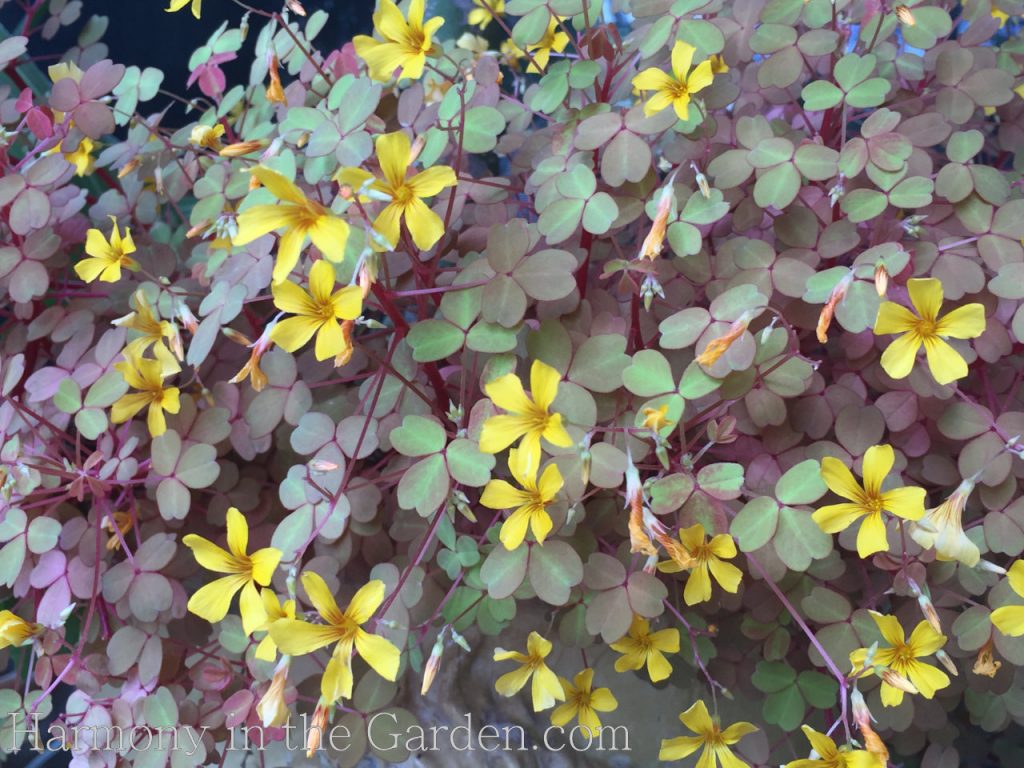
Not wanting to end this article on a sour note (talking about the evil oxalis weed!), I thought I’d highlight a few other spectacular varieties.
I personally haven’t grown these hybrids, only because I’ve never seen them offered in any nursery.
But if I find them, you can be sure I’m going to give them a try!
Oxalis ‘Candy Cane’
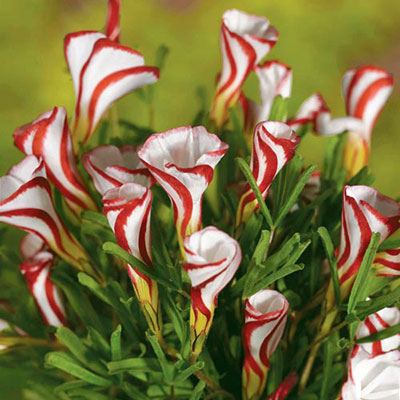
Can you imagine this stunning flower in your garden? I’ve never seen one in person, have you?
Available from DutchBulbs.com
Oxalis brasiliensis
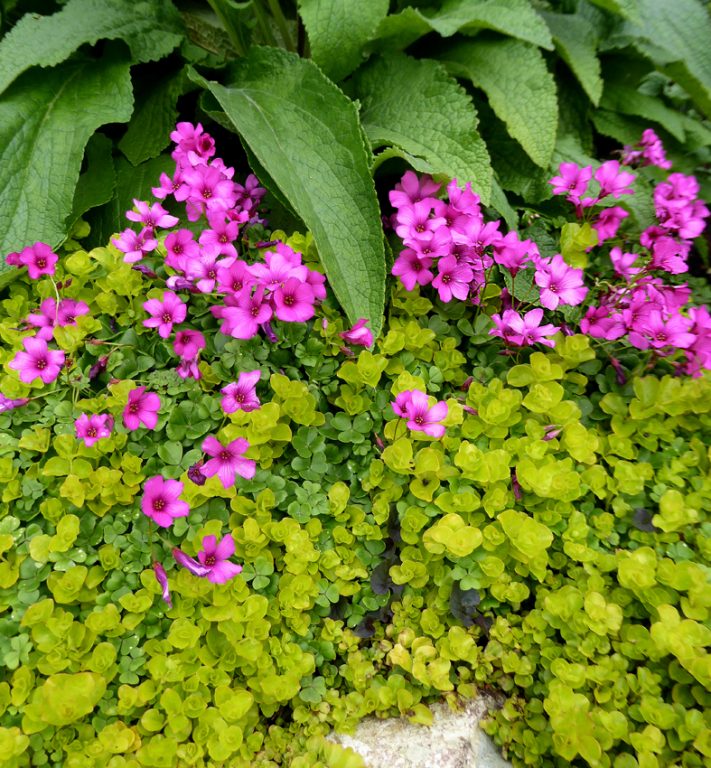
If hot pink flowers are your thing, this variety is a must for your semi-shady garden.
Available at Annie’s Annuals
Oxalis corymbose aureo-reticulata (Gold-Veined Shamrock)
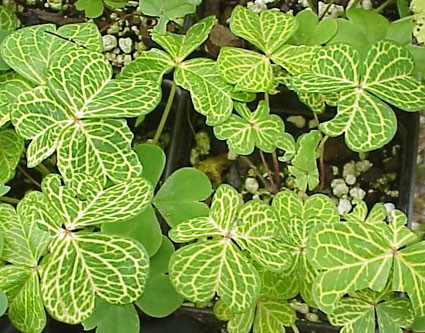
I can imagine some refreshing color combinations as a result of the gold veins in these leaves.
I’m thinking yellow flowers (columbine, perhaps?) or combining this variety with the oxalis spiralis vulcanicola shown above?
Available from Glasshouse Works
Oxalis palmifrons (Palm Leaf False Shamrock)

Is this foliage incredible, or what???
No wonder it’s called the ‘Palm Leaf’ oxalis.
Plant Delights no longer carries this, but their site has some pretty interesting information on it – click here to read.
There seems to be several sites that sell this, including Telos Rare Bulbs. I’ve never ordered from this site, but they seem to have the widest collection of ornamental oxalis I’ve seen yet.
Well, that’s it for today. Tell me, do any of you have a variety not mentioned here?
If so, please share your favorites in the comment section!






20 Comments
I can’t believe there was one more! I’m so glad I saved it! I am gradually finding all my saved for later special emails and this was still among the last few emails. But, I can look at it and plan in advance, hopefully, for next year. I love narcissus (Karen loves the fragrance) and maybe hyacinths? So, we will look around the garden for the empty spots to plant the bulbs ahead of time. Oh boy! So much to look forward to.
Again, thank you for such thoughtful tips.
Carol
Yes, plan ahead for those bulbs! My very favorite for our warm climate are the ‘Avalanche’ narcissus. They’re larger than usual and smell wonderful. Emily plans on ordering lots for her garden this fall, too. 🙂
Help! I’ve grown sunset velvet for several years now and it’s one of the best gardening decisions I’ve made because they’re so hardy and beautiful. However, the latest batch that I put in about a year ago is being eaten. In just a couple of weeks, my normally prolific plot went from healthy and leafy to only stems and stalks. Something is eating the leaves and I don’t know what. Does anybody have any ideas? Ants? Ladybugs?
Oh no!!!! I’ve never had mine eaten like that but I wonder if it’s a voracious slug or snail – can you spot any tell tail signs of slimy snail tracks? I should grow back from the base, however, so maybe transplant it to another location if you can. I just dug a big one up from a container in our Lake Tahoe garden to overwinter here in my warmer Granite Bay garden. It takes a hit, but will bounce back within a few weeks. Good luck to you!
Love this information on Oxalis. I live in Zone 6 so I bring plants inside to care over winter. Now I have to see if I can find some of these beauties especially Candy Cane. That one would look great blooming at Christmas Time? Oh well. Charmed Wine has been potted up for around 6 years.
Glad to hear you’re another oxalis fan, Freida. I’m so glad to hear they overwinter just fine indoors, too. And yes, you must find some of the Candy Cane – it’s SO cute!
Oh Rebecca, I loved reading about all the good Oxalis plants. Then when I saw the Candy Cane variety I just had to have it so I ordered 30 of them, so next fall I will plant for the little darlings to sprout in the spring.
Thanks for all your mailings…..I read every word!
Thirty? Lucky, lucky YOU, Bev!!! I can’t imagine what a spectacular show they’ll put on in your garden – please send photos, won’t you? I’d love to see them and I’m sure my readers would, as well. I’m so happy for you and your garden! 🙂
While at the Northwest Flower & Garden Festival last February, I saw ornamental oxalis at one of the vendor booths and was immediately flooded with memories from my Grandpa’s backyard. Now I’m growing it in hanging baskets.
Hi Toni – nice to hear from you! I have two hanging baskets on my front porch and have been wondering what to put in a blank spot – thanks for the suggestion. It’s perfect!!!
I’ve enjoyed Oxalis regnellii var. triangularis ‘Mijke’ as a ground cover in part shade in front of evergreen screening Shrub/trees shielding my patio from western exposure sun. My start was from a friend, however
Annie’s Annuals sells it. Similar to Charmed Wine? The pink flowers are lovely. Did not go completely dormant in winter in Sacramento 9b. I’ve gradually switched over to selecting many trees, plants for their amazing foliage – I used to think it was all about the flowers! Thanks for the info on these charming varieties. I’ve also been increasing my use of hardy geraniums as endearing ground covers.
Hi Delores – it does seem like they’re similar, doesn’t it! Now that I think about it, I don’t think I’ve planted the ornamental oxalis in the ground before – only containers! Since I live so close to Sacramento, I think I’ll give it a try in my own garden, in front of my camellias. ‘Biokovo’ geranium is my favorite little groundcover, and has performed so well in my garden. Glad to hear they’re working for you, too – I love them!
WOW WOW WOW AND WOW AGAIN!!
I’ve seen several ornamental oxalis and used one in a winow box, but these more ‘rare’ varities are just flat-out amazing!! It is truly unfortunate that they are shunned due to the noxious weeds that their name is associated with.
I’ll enjoy searching them out and hopefully incorporating them into my containers! You are a bottomless well of plant information!!
Ronnie, you’re making me blush – you’re so sweet!!! 🙂 Yes, those rare ones at the bottom of my post are pretty incredible, aren’t they? I found a ‘Sunset Velvet’ a few weeks ago in my favorite Lake Tahoe nursery and promptly bought 2 of them. Sometimes I’ll see them, then I’ll go a few years without seeing any in the nurseries. I think they’re my favorite ones of all as they change colors throughout the year.
I love ornamental oxalis and have a few varieties in my garden, but you have opened my eyes to varieties that I did not know existed. I will be on the hunt for several of these.
Let me know what you find, Nancy! 🙂
What an amazing collection of oxalis, Rebecca. I’ve always loved their delicate leaves, and the soft visual they give to container plantings. The Palm Leaf oxalis has definitely stolen my heart, though. Their leaves are simply incredible. Thanks!
Aren’t they fabulous, Sheila? I’ve never tried the Palm Leaf, but would love to get my hands on one of those. I’ve read that they do well as houseplants, maybe I’ll give that one a try! It looks pretty incredible.
I must have the charmed wine variety, it has lavender blossoms. It has grown in a pot for years and I have to take it out of the sun on really hot days.
I never knew there were so many varieties, something new to look for.
Thank you!
I think the purple leaved varieties must get mislabeled at the nurseries sometimes as I’ve seen the lavender flowered variety marked ‘Charmed Wine’ and also ”Mijke’. But when I look on the internet, it seems the ‘Charmed Wine’ has white flowers. So confusing!!! Either way, I love both!